Physical Address
304 North Cardinal St.
Dorchester Center, MA 02124
Congenital heart disease remains the most common cause of infant death because of a congenital malformation in the United States. Infant mortality rates arising from congenital malformations has declined in the decade from 2005 to 2014. Critical congenital heart disease (CCHD) occurs in 25% of newborns with congenital heart disease and is defined as disease requiring surgery or procedural intervention in the first year of life. In 2011, CCHD was added to the recommended screening panel for newborns by the U.S. Department of Health and Human Services (HHS). Between 2007 and 2013, the death rate of infants with congenital heart disease in mandatory screening states fell from 8 to 6.4 per 100,000 births. During this time period, death from CCHD decreased by 33% in states with mandatory screening compared with states without screening and historical rates in screening states. Not all congenital or neonatal acquired heart disease will be found with the current screening methods. Thus care for newborns demands an awareness of the prevalence of cardiac defects and the ability to differentiate infants with cardiac disease from other critically ill newborns. In 2000, the prevalence of congenital heart disease found by a population study in Quebec was 11.89 per 1000 among children and 5.78 per 1000 in the general population. By contrast, the prevalence of severe congenital heart disease was 1.45 per 1000 children and accounted for 12% of all congenital cardiac lesions in children. The most recent reported birth prevalence in North America was 6.9 per 1,000 live births compared with 8.2 in Europe and 9.3 in Asia. Advances in fetal and neonatal ultrasonographic screening allow identification of an increasing number of children with congenital heart disease and, more importantly, appropriate counseling for their parents. Sixty to seventy percent of newborns admitted to large pediatric cardiac intensive care units have an established diagnosis at the time of birth. Increased rates of prenatal diagnosis have not consistently translated to improved outcomes over the past decade. Although some studies indicate an important benefit of fetal diagnosis in terms of morbidity and mortality, the unintended result is that in some centers, postnatal acute presentations of congenital heart disease are becoming more rare, and this may be detrimental by assuaging fears of congenital heart disease in symptomatic newborns and thus causing delay in care and potentially increased morbidity and mortality. Additionally, fetal diagnosis of heart disease increases maternal anxiety and unhappiness during pregnancy, creating psychologic dysfunction and distress that can persist in both parents for months after birth. Historically, up to 25% of children with congenital heart disease were not diagnosed until after discharge from the newborn nursery, and misdiagnosis was found to occur in up to 7 per 100,000 live births in the United States.
Careful evaluation of the history, physical examination findings, laboratory data (including the response of upper and lower body blood gas concentrations and arterial oxygen saturation in an enriched oxygen environment), radiographic findings, and results of electrocardiography, echocardiography, and occasionally additional imaging such as cardiac computerized axial tomography (CAT), magnetic resonance imaging (MRI), or invasive cardiac catheterization allow the physician to delineate the specific congenital cardiac defect. When a neonate suspected of having congenital heart disease is being examined, it is important to frame physical and laboratory findings within the context of the transition from fetal to neonatal circulation. This chapter considers the physiology and pathophysiology of the fetal and neonatal cardiovascular systems in newborns with and without heart disease.
Newborns undergo dramatic changes in the pulmonary and systemic circulations following birth. In the fetus, oxygen-rich blood from the placenta reaches the right atrium via the umbilical vein and shunts preferentially across the foramen ovale to the left ventricle, providing increased oxygen content to the myocardium and brain ( Fig. 14.1 ). A smaller portion of the highly oxygenated blood passes from the right atrium to the right ventricle and bypasses the lungs via the ductus arteriosus to flow to the lower body. Because of this parallel circulation, individual organs may receive blood from both ventricles, and thus the output of the fetal heart is expressed as combined ventricular output (CVO). Advances in fetal ultrasonographic techniques have enabled a more accurate determination of human fetal blood flow than was previously available using fetal lamb studies. In the normal human fetus, CVO has been documented by echocardiographic studies to be 450 mL/kg/min.
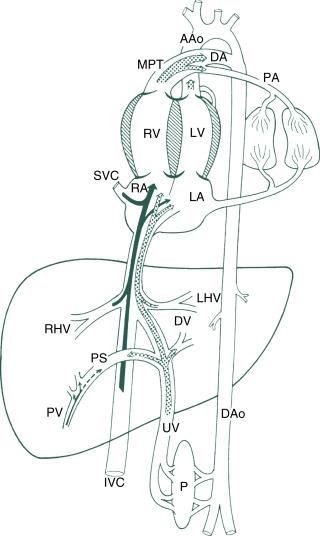
Approximately 45% (200 mL/kg/min) of this blood perfuses the placenta for oxygen uptake and returns via the umbilical veins. Approximately one-half of umbilical venous return enters the inferior vena cava directly through the ductus venosus, thereby bypassing the hepatic microcirculation; the remainder passes primarily through the left lobe of the liver and enters the inferior vena cava via the left hepatic vein. Venous return from the lower body, ductus venosus, and hepatic veins pass into the thoracic inferior vena cava, where there is incomplete mixing. Preferential streaming occurs into various cardiac chambers, with blood from the ductus venosus and left hepatic veins passing preferentially across the foramen ovale into the left atrium. In the normal fetal circulation, oxygenated blood crossing the foramen ovale comprises 76% of the left ventricular output and 33% of combined cardiac output, supplying the cerebral and myocardial circulations. Thus the streaming of blood from the inferior vena cava to the left heart increases the efficiency of oxygen delivery to the most actively metabolizing area of the fetus, the brain. Venous drainage from the right hepatic veins and the abdominal inferior vena cava tends to stream preferentially to the right atrium and right ventricle. Similarly, desaturated superior vena caval return from the cerebral circulation is preferentially directed to the right ventricle through the tricuspid valve. The right ventricle ejects much of this relatively undersaturated blood via the ductus arteriosus back to the placenta. The remainder of the right ventricular output passes into the pulmonary vascular bed. The proportion of CVO to the lungs increases throughout gestation by 60% from 20 to 38 weeks, with pulmonary blood flow accounting for 11% of the CVO. Thus although the circulations are not completely separated, each ventricle primarily performs its postnatal function—the left ventricle delivers blood for oxygen utilization, the right for oxygen uptake.
The left and right ventricles do not eject similar volumes in the fetus. The right ventricle has been shown to be dominant in fetal lamb studies, ejecting almost twice the blood volume ejected by the left ventricle. In human fetuses, the stroke volume of the right ventricle is approximately 28% greater than that of the left ventricle. Left ventricular output is distributed mainly in the upper body, including the brain (∼20% of CVO) and the myocardium (3%); the remainder (∼10%) crosses the aortic isthmus to the lower body.
In the fetus, the ductus arteriosus is part of a specialized system of oxygen-sensitive organs and tissues in the body. Blood flow across the ductus arteriosus is 78% of the right ventricular cardiac output and 46% of the CVO. In comparison with the aorta and the pulmonary arteries, it is thicker walled, with a medial layer composed of longitudinal and spiral layers of smooth muscle fibers within concentric layers of elastic tissue and an intimal layer of smooth muscle and endothelial cells. Continued patency of the ductus arteriosus throughout gestation is controlled by the relatively low fetal oxygen tension and the inhibition of procontractile mechanisms by vasodilators. The vasodilators primarily responsible for ductal patency include prostaglandin and prostacyclin, which interact directly with ductal prostanoid receptors, and to a lesser extent carbon monoxide and nitric oxide.
Fetal echocardiography has significant clinical implications postnatally. As described later in the chapter (see section on echocardiography of the newborn), all echocardiographic techniques can be performed with a fetal echocardiogram. A fetal study is usually performed between 18 to 22 weeks’ gestation for optimal imaging. Studies earlier in gestation can be performed, but a repeat study may be needed to clarify images. Indications for a fetal study can be as a result of either maternal or fetal indications ( Table 14.1 ).
| Maternal Indications | Fetal Indications |
|---|---|
|
|
Aside from cardiac anatomic diagnosis, analysis of fetal blood flow patterns in the ductus venosus, umbilical artery, and umbilical vein can provide information on the overall cardiovascular well-being of the fetus. Fetal echocardiography may also have prognostic implications in patients with congenital diaphragmatic hernia (CDH) and twin-twin transfusion syndrome. From a cardiac standpoint, fetal echocardiography can accurately diagnose most forms of congenital heart defects and their evolution in utero ( Fig. 14.2 ). This may improve the postnatal morbidity and mortality, especially in ductal dependent cardiac defects. Level of parental psychological stress, however, appears to be related to the severity of the cardiac defect and not to a prenatal versus postnatal diagnosis. Another recent use of fetal echocardiography is in conjunction with interventional techniques. Interventions have been reported in fetuses with hypoplastic left heart syndrome and restrictive atrial septum, severe aortic stenosis, and pulmonary stenosis/atresia. Fetal echocardiography is essential for assisting in these procedures.
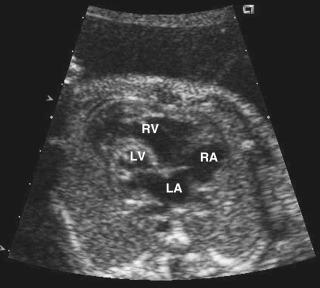
The parallel nature of the fetal circulation makes it uniquely equipped to tolerate most structural abnormalities of the heart that are life-threatening after birth. Even in cases of significant obstruction and falling unilateral ventricular output, the unaffected side of the heart is able to increase its output, and fetal blood flow is redistributed so that the unaffected ventricle can produce most, if not all, of the cardiac output. As a result, cardiac shunts, pulmonary overcirculation, and anatomic causes of systemic hypoperfusion generally do not become noteworthy until the infant is born. There are a limited number of cardiovascular causes of fetal distress that may result in the development of hydrops, including arrhythmias, myocardial disease, severe atrioventricular (AV) or semilunar valve insufficiency, and premature constriction of the ductus arteriosus with a restrictive atrial septum. All of these conditions share a final common pathway of elevated ventricular end-diastolic pressure, increased atrial and central venous pressure, and movement of fluid from the capillary bed into fetal tissue.
Sustained tachyarrhythmias (over 200 beats per minute) for more than 12 hours continuously or bradycardia associated with congenital heart disease are not well tolerated. Tachyarrhythmias may be controlled by administering antiarrhythmic medications to the mother, including digoxin, beta-blockers, sotalol, flecainide, and amiodarone. Digoxin is a first-line therapy for short ventriculoatrial supraventricular tachycardia (SVT) and atrial flutter in the absence of hydrops and is associated with an 80% to 85% success rate in the treatment of fetal SVT and a 60% to 65% success rate for atrial flutter. Sotalol is another first-line therapy with a 72% conversion rate. Arrhythmia control is likely to be successful if treatment is initiated before the development of hydrops. Successful treatment of supraventricular tachyarrhythmias in the presence of hydrops is more complex and typically requires the use of at least two medications and a longer therapeutic course. Incessant fetal SVT warrants an attempt at conversion with intraumbilical administration of antiarrhythmic medications. Even with successful treatment, there is an 8% to 30% reported risk of fetal or neonatal mortality.
Fetal bradycardia may be associated with significant intrauterine mortality. The outcome for bradycardia in the fetus is determined by the cause. Sinus or low atrial bradycardia is seldom symptomatic and does not require treatment. Persistent and asymptomatic bradycardia is most commonly associated with long corrected QT interval (QTc). No treatment is necessary for the fetus unless there is associated ventricular tachycardia or torsades. Another etiology of fetal bradycardia, AV block, is estimated to occur in 1 in 22,000 live births. AV block is caused by maternal autoantibodies in approximately 45% to 48% of cases and can present as early as 18 weeks’ gestation. There have been reports of successful treatment of early low-grade heart block, with improvement in outcomes by administration of fluorinated steroids to the mother, but there have been no randomized studies with adequate follow-up. Beta-sympathomimetic agents, intravenous immunoglobulins, and direct fetal pacing are also being used as therapies for autoimmune-mediated fetal AV heart block. Another 45% to 55% of fetal AV block is associated with structural heart disease (most commonly left atrial isomerism and congenitally corrected transposition of the great arteries [TGA]). Unfortunately, even with aggressive intervention, survival of infants with AV block associated with structural heart disease is particularly dismal, with a 75% to 90% incidence of fetal or neonatal demise.
Structural heart disease is the most common cause of fetal heart failure and may lead to significant mortality without intervention. Some fetuses with severe semilunar valve stenosis are candidates for an attempt at intrauterine valvuloplasty to stabilize the patient’s condition and ideally improve long-term surgical options. Technical success is increasing, and there has been success in altering the natural history of the disease. Early delivery with immediate intervention is often the best management strategy for fetuses who show symptoms associated with specific structural heart defects such as ductus arteriosus restriction, Ebstein anomaly of the tricuspid valve, or tricuspid valve dysplasia with significant tricuspid insufficiency.
By the end of the third trimester, the fetal pulmonary circulation begins to demonstrate vasoreactivity and responsiveness to maternal hyperoxygenation. The onset of breathing produces a dramatic increase in pulmonary blood flow (from 11% of the CVO to a full cardiac output) and a decrease in pulmonary vascular resistance (PVR). With the onset of ventilation, air replaces intra-alveolar fluid, and local oxygen concentration increases markedly, both of which may directly dilate the pulmonary vascular smooth muscle or cause the release of vasodilating substances. Bradykinin, a potent pulmonary vasodilator, is released when the lungs are exposed to oxygen; bradykinin, in turn, stimulates endothelial cell production of nitric oxide, a potent vasodilator. Prostacyclin (prostaglandin I 2 ), a pulmonary vasodilator derived from the metabolism of arachidonic acid, is released when the lung is mechanically ventilated (not necessarily oxygenated) or exposed to other vasoactive substances such as bradykinin or angiotensin II. Inhibiting prostaglandin production by administering a cyclooxygenase inhibitor (such as indomethacin) attenuates the normal ventilation-induced decline in PVR, which further supports the role of these vasoactive substances in the establishment of a normal pulmonary circulation after birth. Clamping the umbilical cord removes the low-resistance placental circulation and immediately increases the infant’s systemic vascular resistance (SVR). The increase in pulmonary blood flow greatly alters the venous return to the left atrium and consequently the left ventricular preload. Left ventricular cardiac output increases from an estimated 179 mL/min/kg to approximately 240 mL/min/kg within the first 2 hours after birth because of increased stroke volume. As the ductus arteriosus closes and the left-to-right shunt diminishes, left ventricular output falls to approximately 190 mL/min/kg.
The initial dramatic decrease in PVR is secondary to relaxation of the resistance vessels. There is then a slow, progressive decline over the next 2 to 6 weeks of life as these pulmonary arterioles remodel from their fetal pattern, in which a large amount of smooth muscle is present in the medial layer, to the adult pattern, with very little muscle in the media. The development of the “physiologic anemia” that normally occurs during this time decreases the viscosity of the blood perfusing the lungs, which decreases shear stress and also contributes to the overall decrease in PVR.
Functional closure of the foramen ovale occurs after the placenta is removed from the circulation. With clamping of the umbilical cord, blood flow through the inferior vena cava to both atria decreases dramatically. Initiation of breathing increases blood flow through the pulmonary bed to the left atrium. These changes result in a left atrial pressure that now exceeds the right atrial pressure, which causes the valve-like flap of the foramen ovale to close. Although functional closure of the foramen ovale occurs in most infants, anatomic closure is not always complete. As a result, any action that raises right atrial pressure to the point that it equals or exceeds left atrial pressure can result in a right-to-left shunt across the foramen ovale. Likewise, in conditions that have large left-to-right shunts, such as a large patent ductus arteriosus (PDA) or ventricular septal defect (VSD), the left atrium may become dilated, which results in stretching of the atrial septum and incompetence of the foramen ovale and a left-to-right shunt. In many adults, despite the events leading to functional foramen closure, a probe-patent foramen may persist.
Closure of the ductus arteriosus is a more complex phenomenon. The media of the ductus arteriosus contains smooth muscle in a spiral configuration that is maintained in a relaxed state, primarily by the action of prostaglandins. Constriction and closure after birth reflect removal of the stimuli that maintain relaxation and the addition of factors that produce active constriction. Circulating prostaglandin E 2 (PGE 2 ) concentrations in the fetus are high because of the very low pulmonary blood flow. With clamping of the placenta, the source of PGE 2 is removed. With inspiration, there is a dramatic increase in pulmonary blood flow and an abrupt increase in oxygen tension that inhibits ductal smooth muscle voltage-dependent potassium channels and results in an influx of calcium and ductal constriction. In addition, the remaining PGE 2 is almost completely metabolized as it passes through the pulmonary circulation, which results in a rapid decrease in serum levels of PGE 2 and allows active constriction of the ductus arteriosus to be unopposed. The ductus arteriosus constricts rapidly; in mature infants, functional closure generally occurs within 10 to 15 hours after birth. Permanent closure by intimal cushion formation, intimal proliferation, fibrosis, and thrombosis may take several weeks.
Fetal myocardium differs from neonatal and adult myocardium in several important ways. The primary fuel for fetal myocardium is almost exclusively glucose in contrast to the adult heart, which can use fatty acids as a significant energy source. In addition, especially early in gestation, the fetal heart grows by hyperplasia of the myocardial cells in contrast with the newborn heart, in which the myocardium grows by hypertrophy. Fetal myocardium also functions distinctly by developing less active tension for a given stretch than does adult myocardium and therefore has less ability to contract. Thus ventricular output can be increased only modestly by volume loading and only at relatively low atrial pressures; unlike in the adult, output increases only slightly at levels more than 2 to 4 mm Hg above baseline. Inotropic stimulation of the fetal myocardium also increases cardiac output relatively little. This inability to respond to changes in preload and in the inotropic state is related in part to immaturity of muscle structure. Early in gestation, there are relatively fewer contractile elements, an immature sarcoplasmic reticulum with lower affinity for calcium binding, and a somewhat chaotic overall arrangement of fibers with considerable interstitial tissue. Infants born preterm have been shown to have persistent abnormalities of their myocardium. Toward term, more contractile elements are present, and these are more mature and are arranged in a more orderly fashion. Another factor limiting fetal myocardial performance is incomplete sympathetic innervation, which limits response to inotropic stimulation. The fetus is best able to increase ventricular output by increasing its heart rate. There is a linear relationship between ventricular output and heart rate up to about 250 beats per minute; thereafter, ventricular output reaches a plateau and even starts to decline. As heart rate goes below the normal range, ventricular output decreases dramatically because of the limited ability to increase stroke volume. As a result, the fetal myocardium is operating under a high-volume load and responds poorly to any increase in ventricular afterload. Although adrenergic support can be supplied either by circulating catecholamines or through neural pathways, the overall quantitative response may be less than in the adult. The control of cardiac rate and the distribution of cardiac output are the major mechanisms for maintenance of circulatory function.
As discussed previously, the left ventricular cardiac output increases dramatically within the first 2 hours after birth and remains elevated for several weeks before decreasing to approximately 190 mL/min/kg. Because of the high resting values in the period immediately after birth, ventricular output can be increased only modestly by volume loading or inotropic stimulation with dopamine and dobutamine. The neonatal myocardium remains sensitive to the administration of the calcium ion and responds positively to the lusitropic effects of milrinone. After the initial newborn period, resting values decrease progressively, and ventricular output can be increased much more effectively.
The normal physiologic values in the heart and great vessels are shown in Fig. 14.3 . Pulmonary arterial pressures (PAPs) in the newborn are variable but generally decrease to half of systemic pressure within 8 to 12 hours and to one-third of systemic pressure within a day or so. Over the next 4 weeks, there is a further slow, progressive decline to adult levels.
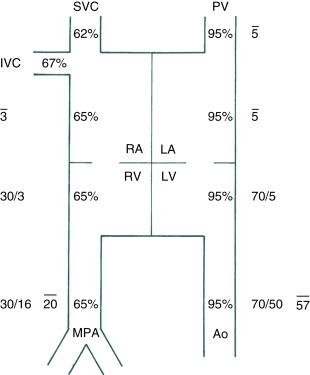
The oxygen saturation on the right side of the heart is approximately 60% to 70%; that on the left side of the heart is 92% to 95%. The oxygen saturations may be used to determine the direction of shunting within the heart or great vessels. For example, an increased saturation in the right atrium suggests a left-to-right shunt at the atrial level; a decreased saturation in the left atrium in a neonate with otherwise healthy lungs indicates a right-to-left shunt at the atrial level.
Flow ( Q ) through a vascular bed is governed by the resistance to flow ( R ) and the pressure decrease across the bed (Δ P ) (Ohm’s law).
Furthermore, by application of Poiseuille’s law, resistance to flow is directly related to the viscosity of the blood and inversely related to the cross-sectional area of the bed (radius).
An appreciation of the general relationship of pressure, resistance, and flow is important in understanding the pathophysiology and natural history of various congenital heart defects.
Blood flows where resistance is least.
Vascular resistance is calculated from the formula
For the systemic circulation, the Δ P (pressure decrease) is systemic arterial pressure (SAP) minus systemic venous pressure (SVP); for the pulmonary circulation, the Δ P is PAP minus pulmonary venous pressure (PVP).
If the pressure decrease is measured in millimeters of mercury and the flow is measured in liters per minute per square meter, then the calculated vascular resistance is considered in resistance units. One resistance (or Wood) unit is equal to 80 dyne • sec/cm 5 . The maximum normal PVR is 2.5 to 3 units, and the maximum normal SVR is 15 to 20 units.
Peripheral vascular resistance is not the only type of resistance that will affect flow. For example, a narrowed valve provides more resistance to blood flow than does a wide-open valve; a small VSD provides more resistance to blood flow than does a large VSD; and a thick, noncompliant ventricular chamber provides more resistance to blood flow than does a thinner, more compliant ventricular chamber.
If two similar cardiac chambers or arteries (one left-sided or systemic and the other right-sided or pulmonary) communicate with each other and the opening between them is so large that there is little or no resistance to blood flow, the defect is considered nonrestrictive . The pressures on each side of the opening are fully transmitted and approximately equal. If the opening is small (restrictive), there is resistance to blood flow, and the pressures are not fully transmitted. In the presence of a nonrestrictive defect, the resistances to outflow (downstream resistance) from each of the two communicating chambers determine the direction of blood flow. For example, with a large VSD in which ventricular pressures are equal, PVR is usually lower than SVR, and pulmonary blood flow is greater than systemic blood flow; that is, a left-to-right shunt is present ( Fig. 14.4A ). Because the flows and shunting pattern depend on the relationship of the downstream pulmonary and SVRs, these are called dependent shunts. When the two resistances are equal, no shunt occurs ( Fig. 14.4B ). When resistance to outflow of the right ventricle exceeds that of the left ventricle ( Fig.14.4C )—as might occur with the development of pulmonary vascular disease or, more commonly, when there is an associated pulmonic stenosis (tetralogy of Fallot)—right-to-left shunting is present. When there is a communication between the two sides of the heart at different anatomic levels (e.g., arteriovenous malformation, left ventricular–right atrial communication), the pressure difference between the two chambers or vessels, rather than downstream resistance, dictates the magnitude of the shunt; these are called obligatory shunts. For example, in a left ventricular–right atrial shunt, blood shunts continuously through the defect because the left ventricular pressure is always higher than right atrial pressure, regardless of the distal pulmonary and SVRs.
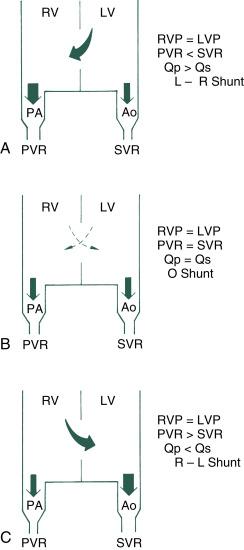
It is customary to relate the cardiac outputs and pressures in each side of the heart. Thus if there is three times as much flow into the pulmonary artery as into the aorta, there is a 3 to 1 pulmonary-to-systemic flow ratio. If the pressure in the pulmonary artery is 60 mm Hg and that in the aorta is 90 mm Hg, pulmonary hypertension is at two-thirds of the systemic level.
It is imperative to perform a complete physical examination of all neonates and to monitor for ongoing changes suggestive of pathologic conditions. In 2010, HHS Secretary’s Advisory Committee on Heritable Disorders in Newborns and Children recommended screening for congenital heart disease be added to newborn screening programs. The screening targeted ductal-dependent lesions with high mortality and morbidity without accurate diagnosis. A 2017 study demonstrated a 33% decrease in deaths from CCHD in states with mandatory screening. As of December 2017, 47 states and the District of Columbia mandated pulse oximetry screening for congenital heart disease. Although pulse oximetry screening is a valuable tool in identifying infants with CCHD, the remainder of the physical examination should not be neglected, and the infant in extremis should be considered with a wide differential. An infant with known heart disease remains susceptible to other disease processes, including bacterial sepsis, anemia, and pulmonary disease. Acutely ill infants may have several simultaneous working diagnoses while caregivers are stabilizing their physiologic condition. In these instances, some additional factors may suggest cardiac abnormalities. Dysmorphic or syndromic features in any neonate should prompt the clinician to pay particular attention to the cardiovascular system as the infant transitions to postnatal life.
From an analysis of 21 studies including half a million screened babies, Plana concluded that of 10,000 apparently healthy late preterm or full-term newborn infants, 6 will have critical congenital heart defects. Screening by pulse oximetry will detect 5 of these infants as having CCHD and will miss one case. In addition, screening by pulse oximetry will falsely identify another 14 infants out of the 10,000 as having suspected CCHD when they do not have it. Fewer false positives were noted when pulse oximetry was performed longer than 24 hours after birth. They concluded that pulse oximetry screening is highly specific and a moderately sensitive test for detection of CCHD with very low false-positive rates. Current evidence supports the introduction of routine screening for CCHD in asymptomatic newborns before discharge from the well-baby nursery. Many of the so-called false positives have respiratory problems or sepsis, so the test is extremely valuable.
Central cyanosis indicates a reduced arterial blood oxygen saturation and is generally visible when reduced hemoglobin in the blood exceeds 5 g/dL (saturation ≤85% in patients with a normal hemoglobin level). If the lungs are functioning normally, the level of systemic arterial blood oxygen saturation depends entirely on the effective pulmonary blood flow—that is, the amount of blood oxygenated by the lungs that subsequently passes into the systemic arterial circulation. Neonates frequently experience acrocyanosis that is unrelated to heart disease. The best method of assessing for central cyanosis in an infant is to look at the tongue. Other diagnostic procedures are needed to determine the cause of the cyanosis. Comparing arterial blood oxygen saturation or P o 2 above and below the ductus arteriosus may be beneficial. In addition, the “hyperoxia” test, or ventilation with a high inspired oxygen concentration, is frequently considered a valuable diagnostic tool. An increase of more than 50 mm Hg (and often much higher) in systemic arterial P o 2 is seen in infants with primary pulmonary problems (especially because high levels of oxygen tend to dilate the pulmonary arterioles and decrease the PAPs). A PaO2 of less than 100 mm Hg in an enriched oxygen environment indicates congenital heart disease until proven otherwise and should prompt an echocardiographic examination and the initiation of PGE 2 therapy. Frequently, the practicalities adhere less to the textbook: a significant increase in systemic arterial blood oxygen tension or saturation can occur in cyanotic heart disease as long as effective pulmonary blood flow is reasonable. Therefore a PaO2 of 100 to 250 mm Hg may be suggestive of congenital heart disease and warrants additional investigation. A PaO 2 above 250 mm Hg makes life-threatening cyanotic heart disease less likely. If a hyperoxia test is performed, direct oxygen measurements should be made simultaneously in the upper and lower body to exaggerate any potential difference and thus help delineate the presence of a right-to-left ductal shunt. The measurement of upper and lower body saturation during crying can also help exaggerate potential differences because of ductal shunting.
The pulse oximeter is your friend. It is readily available, and measuring upper- and lower-limb pulse oximetry can give a lot of valuable information, particularly when combined with a hyperoxia test.
Most infants with mild arterial oxygen desaturation are tachypneic because of chemoreceptor stimulation but show little or no respiratory distress. Congenital heart disease that presents with respiratory distress is very difficult to diagnose in infants: their symptoms are usually more insidious and less dramatic than cyanosis, the differential diagnosis is broader, and the yield of heart disease is much less, which lowers one’s index of suspicion. When a physician sees a newborn lying in a crib, blue and comfortable, the diagnosis is almost always cardiac disease; when the infant is acyanotic, tachypneic, and showing retractions, it is usually not. Infants with respiratory distress usually have modest degrees of systemic blood oxygen desaturation, depending on the type of circulatory derangement and the severity of pulmonary edema. The respiratory distress is related to decreased lung compliance in these patients, and interstitial fluid is usually present. Thus even with a normal separation of circulations, some degree of hypoxemia is present.
The cardiac impulse should be palpated. Obvious cardiac malposition in the right chest should be documented and warrants additional evaluation. The right ventricular impulse is dominant in a newborn.
Heart sounds in most newborns with significant congenital heart disease are abnormal. The rapid heart rates of most neonates can make this determination difficult even for the experienced practitioner. Multiple studies have assessed the skill of pediatric cardiologists and general pediatricians in detecting heart disease in inpatient neonatal settings and have found sensitivity rates of 80% to 83% for congenital heart disease. A single-second sound after the first 12 hours may indicate atresia of a semilunar valve or transposition of the great arteries. The presence of a pulmonary systolic ejection click may be normal in the first hours, but after that, any systolic ejection click is abnormal, indicating an abnormal pulmonary or aortic valve, an enlarged pulmonary artery or aorta, or truncus arteriosus. If the infant has pulmonary disease without congenital heart disease and has a narrowly split- or single-second sound, then a high PVR is expected. Although systolic murmurs are more easily distinguished than the first and second heart sounds, they are common during the neonatal period and have historically been reported in up to 60% of healthy newborns. Studies have demonstrated a higher incidence of congenital heart disease in infants with murmurs in the neonatal period. In a study of 7204 consecutively examined newborn infants, fewer than 1% of the neonates were found to have cardiac murmurs. All neonates with cardiac murmurs were referred for echocardiography, and an underlying cardiac malformation was diagnosed in 54% of them. A retrospective review of 20,323 live births over a 3-year period in a hospital in Israel found 170 newborns with an isolated finding of a heart murmur who were referred for echocardiography. Of those infants, 147 (86%) were found to have structural heart defects, including isolated VSD (37%), PDA (23%), and combined VSD and PDA (7%); abnormalities creating left-to-right shunts comprised 66% of the diagnoses. Certain murmurs noted in the neonatal period are nearly diagnostic. An S 4 gallop is always abnormal.
Whereas the echocardiogram and pulse oximeter are trending to make the stethoscope obsolete, there is still much to be learned from careful observation of color, palpation of all the pulses, and auscultation, as described above.
Hepatomegaly is a nonspecific finding that may be indicative of increased central venous pressures. It can be associated with cardiac lesions that volume-load the right side of the heart (such as a systemic arteriovenous malformation, anomalous pulmonary venous return, or right-sided valve insufficiency, as seen with Ebstein anomaly and absent pulmonary valve syndrome). Hepatomegaly may also be associated with low-output states such as myocarditis, cardiomyopathy, cardiogenic shock following ductal constriction in a ductal dependent systemic lesion, and tachyarrhythmias.
It is imperative to palpate femoral and radial pulses in all newborns. Bounding pulses are typically associated with a widened pulse pressure and may be found in congenital abnormalities with increased diastolic pulmonary blood flow. Diminished femoral pulses or brachial–femoral delay may be associated with coarctation of the aorta, hypoplastic left heart syndrome, or an interrupted aortic arch. Inability to palpate pulses in all extremities should prompt the examiner to palpate the right carotid or temporal artery. If these pulses remain intact, the diagnosis would include an aberrant subclavian artery in addition to aortic arch obstruction. If all pulses are severely diminished, the obstruction to blood flow is at the aortic valve or within the left ventricle. Diminished femoral pulses should prompt the clinician to initiate therapy with prostaglandin infusion while awaiting confirmatory imaging or transfer to another center.
Accurately diagnosing the anatomy and physiology of the cardiac defect is the cornerstone for pediatric cardiology. To accomplish these goals, multiple imaging modalities are available. Currently, the most frequent techniques for imaging in the NICU are echocardiography, CAT scans, MRI, and cardiac catheterization. The decision to obtain one or more of these studies will depend on the history, clinical exam, and clinical course of the patient. With the use of these imaging techniques, a complete assessment of the cardiac defect can be obtained to aid for an optimal clinical outcome. This section will focus specifically on the uses of these techniques in the NICU.
Echocardiography remains the main imaging technique in pediatric cardiology. An echocardiogram is likely the first cardiac imaging technique that will be obtained to rule in or out a cardiac abnormality ( Table 14.2 ). Most clinical and surgical decisions can be made purely from the echocardiographic exam. Advantages of echocardiography include its portability, noninvasive nature, real-time information, safety, and overall ease of use. Disadvantages of echocardiography include limitations in imaging because of some clinical scenarios and only fair ability to accurately diagnose certain complicated extracardiac vascular anomalies.
| Syndromes | Trisomy 13 Trisomy 18 Trisomy 21 CHARGE association VACTERL association DiGeorge syndrome Noonan syndrome Turner syndrome William syndrome |
| Nonsyndromes | Congenital diaphragmatic hernia Omphalocele Midline abnormality workup Tracheoesophageal fistula |
| Other | Unexplained hypoxemia Abnormal cardiac exam Perinatal asphyxia Persistent positive blood cultures Genetic abnormalities not otherwise specified |
Echocardiography is the application of ultrasound to obtain an image via reflected sound waves. Higher-frequency probes, usually 5 MHz or higher, are used in the NICU because minimal penetration of the sound wave into the patient is needed, and the shorter wavelengths allow for clearer resolution of the images. Scatter of the ultrasound wave, which inhibits image quality, usually occurs between interfaces of material that have disparate density. Bone and air, when adjacent to soft tissue or fluid, produces significant artifacts, whereas soft tissue next to fluid produces minimal artifact. As such, clinical scenarios, such as a pneumothorax or bronchopulmonary dysplasia (BPD), may minimize image quality.
A complete and standardized approach is needed for the initial echocardiographic evaluation of the neonate. The usual examination consists of the probe placed just to the left of the sternum to obtain parasternal long ( Fig. 14.5A–C ) and short axial images ( Fig. 14.6A–C ) at the apex of the heart to obtain an apical four-chamber view ( Fig. 14.7A–C ), subxiphoid to obtain subcostal coronal ( Fig. 14.8A–C ) and sagittal images ( Fig. 14.9A–C ), and in the suprasternal notch to obtain suprasternal long- ( Fig. 14.10A,B ) and short-axis views ( Fig. 14.11A–B ). More views may be obtained depending on the complexity of the anatomy. If the heart is displaced, as in the case of dextrocardia or CDH, adjustments of probe position are required. Numerous sweeps with application of M-mode, two-dimensional analysis, Doppler, and color Doppler allow for an inclusive examination that will give anatomical, physiologic, and functional data. For a complete review, the reader is referred to recent textbooks Echocardiography in Pediatric and Adult Congenital Heart Disease , eds. Eidem BW, Cetta F, and O’Leary PW; or Echocardiography in Pediatric and Congenital Heart Disease: From Fetus to Adult , eds. Lai WW, Mertens LL, MS Cohen, and Geva T.
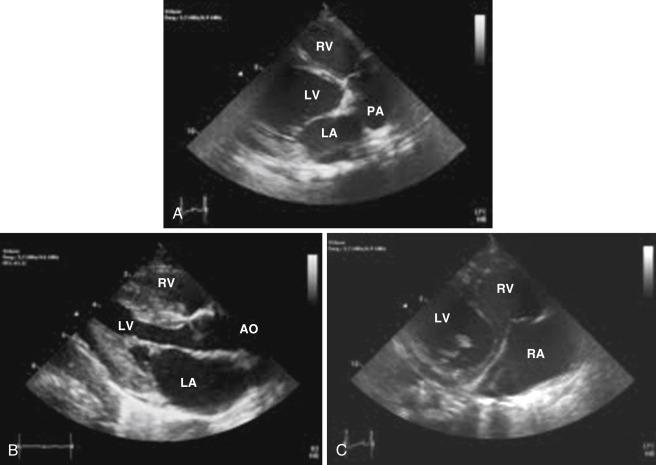
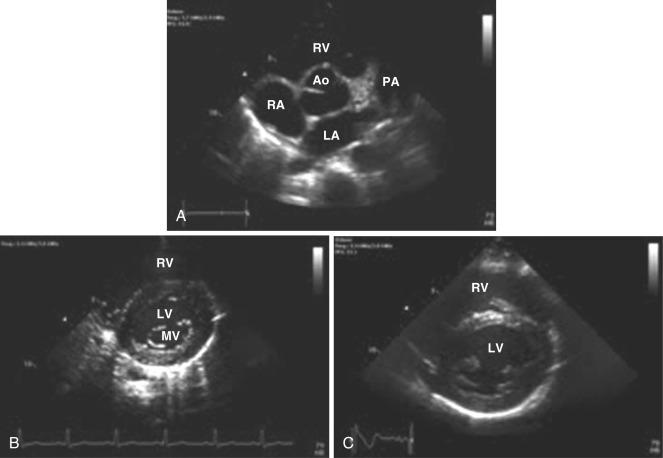
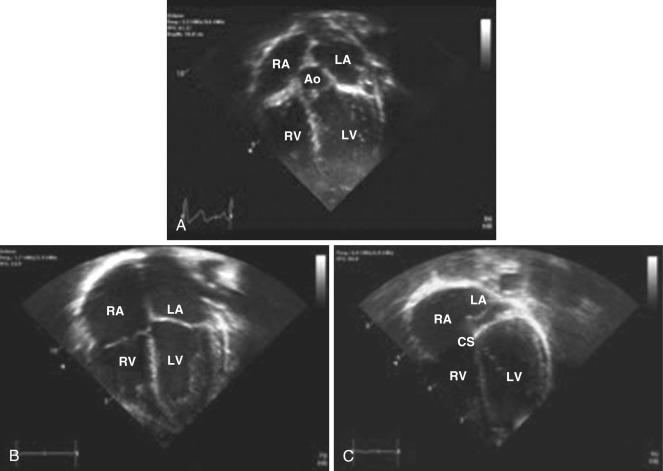
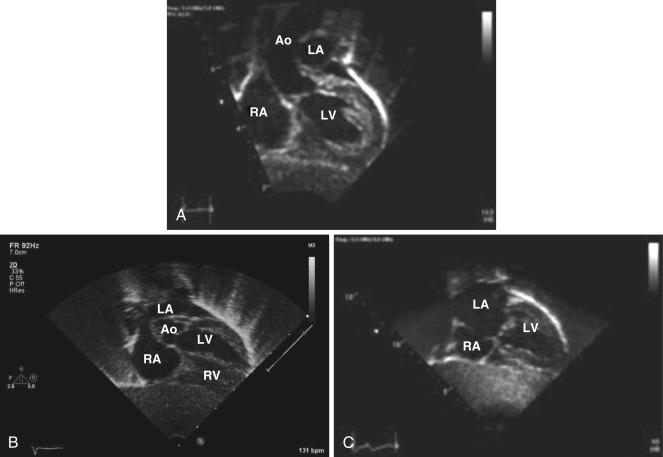
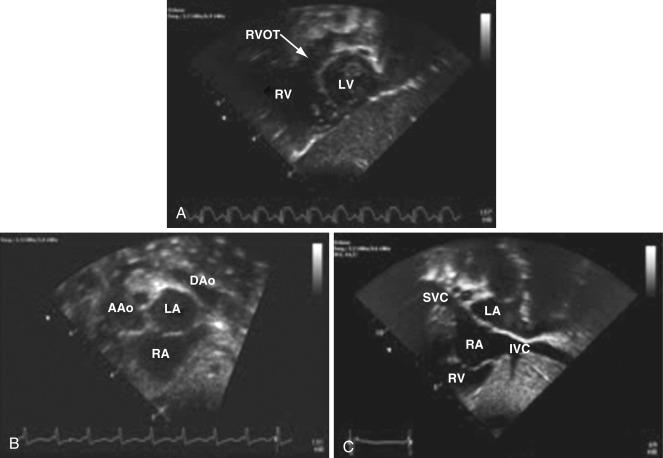
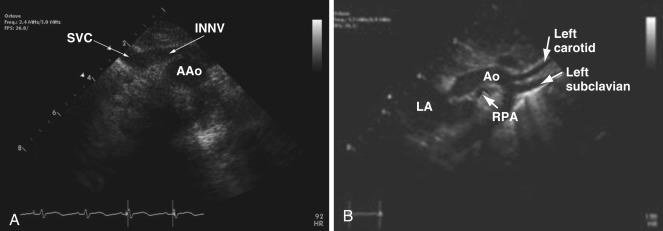
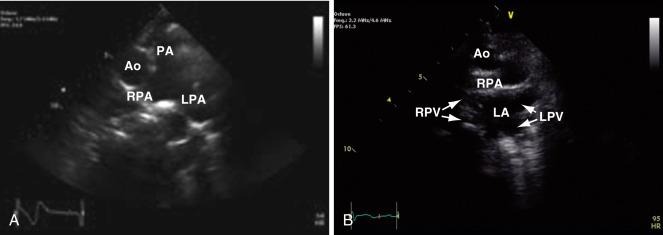
M-mode echocardiography was one of the earliest techniques for evaluating cardiac structures. A single line of interrogation is obtained and plotted over time ( Fig. 14.12 ). Two-dimensional echocardiography has largely replaced this modality, but M-mode is still used mainly to calculate shortening fraction and measure wall thickness and chamber size, though guidelines are always updated. This is usually obtained in the parasternal short-axis view at the level of the papillary muscle ( Fig. 14.13 ). Shortening fraction is defined as (left ventricular end-diastolic dimension–left ventricular end-systolic dimension)/left ventricular end-diastolic dimension. A normal value is anything above 28%. Limitations of M-mode include the fact that it involves only a single plane to estimate global function; thus regional wall abnormalities may be missed. It is also fairly preload dependent and does not measure intrinsic myocardial contractility per se. Shortening fraction also assumes normal electrical conduction and a circular shape of the left ventricle. Conduction abnormalities or flattening of the interventricular septum that may occur with dilated right ventricular volumes because of shunts or elevated right ventricular pressures attributed to persistent pulmonary hypertension of the newborn (PPHN) may invalidate these measurements. Normative data are available for wall thickness and chamber sizes and are usually referenced to a z -score. A z -score is simply a standard deviation, and if a z -score is within ± 2, it is considered normal.
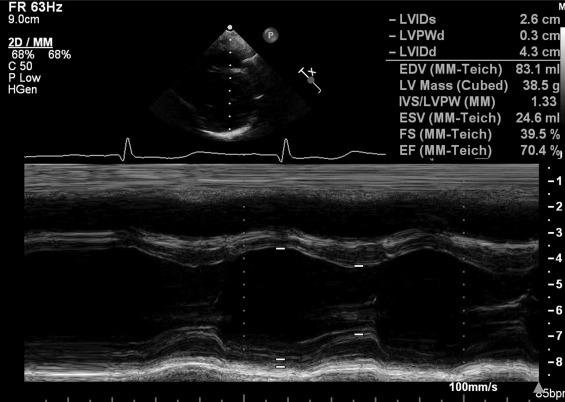
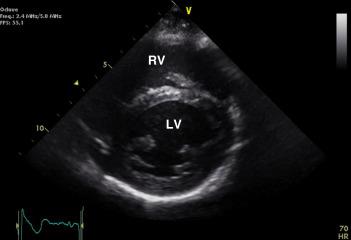
As stated, use of two-dimensional echocardiography via numerous views is the most common way that a cardiac anatomical diagnosis is made. Systolic function can also be qualitatively and quantitatively obtained. Tracing the left ventricular chamber in end systole and end diastole can give an estimate of ventricular volume, and thus an ejection fraction can be calculated similarly to shortening fraction. In general, an ejection fraction above 50% is considered normal. In addition to anatomic diagnosis and function analysis, secondary changes to chamber sizes may give physiologic clues. For example, a PDA may be large by dimensions, but if left-sided structures are not enlarged, there may be minimal left-to-right shunt, possibly because of PPHN or not enough time has passed for these changes to be noted.
Become a Clinical Tree membership for Full access and enjoy Unlimited articles
If you are a member. Log in here